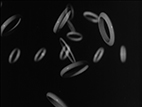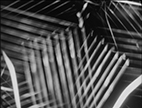Rhythm in Light - Mary Ellen Bute
- Unseen Cinema Collection |
- 1934 |
- 5 minutes |
- B&W |
- SOUND
Rental Format(s): Digital File
Co-makers: Mary Ellen Bute, Theodore Nemeth, and Melville Webber
Original Format: 35mm sound film 1.33:1
Music: Edvard Grieg
Courtesy: Mary Ellen Bute, Theodore Nemeth, Jonas Mekas
Bute used Webber's experience (Fall of the House of Usher, 1928, Lot in Sodom, 1933) with making cardboard models and with photographing in soft-focus and through prisms to produce multiple refractions and reflections. In addition, she used cellophane, ping-pong balls, sparklers, eggbeaters, and bracelets to create a work that, while pushing toward abstraction, does not completely leave the objective world behind. -R. Bruce Elder
By 1934, Mary Ellen Bute (1906-1983) was purposefully engaged in making abstract films and by 1954 was exploring electronic imagery. Trained in painting and stage lighting, she continued theoretical studies with mathematician Joseph Schillinger and musician Leon Theremin. Her early collaborators in film were Schillinger, Lewis Jacobs and Melville Webber, but it was with cameraman Ted Nemeth that she realized an ongoing series of short "seeing-sound" films. She also filmed a feature-length version of James Joyce's Finnegan's Wake. -Bruce Posner
Before filming Mary Ellen Bute's short abstract films (1931-1953), Theodore "Ted" J. Nemeth (1911-1986) learned his craft creating special effects for feature film "trailers." As head of his own New York studio, founded in 1940 the year Bute and he were married, he made documentaries, commercials, and short subjects, two of which were Academy Award nominees. -Aram Boyajian
Melville Webber (1896-1947) pursued parallel careers in art history, archeology, poetry, art, and motion pictures. He is primarily known for collaborating on films with Watson, but he also assisted Mary Ellen Bute with Rhythm in Light (1934). Soon after, his fortunes shifted, and he suffered a nervous breakdown from which he never fully recovered. -Bruce Posner






